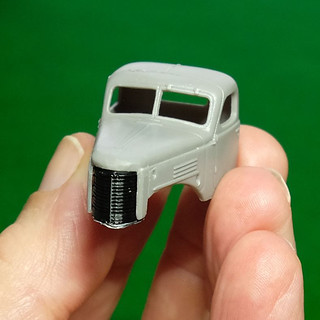The K7 Mudguards...
The original American K7 truck had pretty beefy mudguards, but the Soviets soon got rid of those for something simpler (and cheaper to make). So, to turn my current kit back into it's precursor I'll have to make a set of these rounded mudguards to turn the Zil-157 back into the good old American K7!
But, how to do it? 😐
 |
| The American IH K7 - I like big mudguards and I cannot lie... |
Creating an accurate and complex 3D model is a bit beyond my software skills (for now) so I had to take a sneakier tack. I spent some time trawling through the 3D model repository THINGYVERSE to see if I could find at least something similar looking (these big rounded mudguards were pretty common in the 1940s & 50s). Maybe there was another WW2 truck model I could filtch the mudguards from?
Well, and this is a funny story, it turns out there wasn't a suitable WW2 truck model BUT - for some strange reason - they did have a model of a 1950s Romanian Steagul Roșu SR-101...And you are not going to believe this (I didn't) but the SR-101 was a Romanian copy of the Soviet Zis-150 which was a copy of the US K7! 😂
 |
| The Romanian Steagul Roșu SR-101 - a copy of a copy of the K7! |
Nothing I do is ever straight forward, but until I learn how to use a proper 3D modelling program - so I can create my own models - I'm going to have to settle for these half-assed shenanigans (making very simple models and 'borrowing' shapes/parts from Thingyverse).
Anyway, I downloaded the 3D model files and opened the one relating to the cab component and happily there were those lovely big mudguards...
The messing around didn't end there though, after I did a quick test print I found that the model was not scaled accurately (typical). So, I had to do some measuring and some quick math and rescaled it so that the mudguards matched the size of my plastic kit's cab.
I printed the model out using the new black PLA I bought and set the quality to 'high' to make sure the rounded mudguards came out as smoothly as possible...
Not bad at all! 😊 Some of the cab was a bit messy (not my printer's fault, it was a crumby model) but fortunately the important bits were fit for purpose. It was now just a case of cutting the mudguards off the 3D model and doing a bit of a Dr. Frankenstein by transplanting them onto my Zil-157's cab.
Out comes my little multitool and a thin circular cutter...
First of all, I roughly cut out a chunk of the trucks bonnet including the mudguard. Then I carefully trim away the unwanted bits of the 3D print until I'm left with just the mudguard component itself.
Once I have a roughed piece I try a bit of preliminary fitting to get an idea how I will go about cleaning up a finished mudguard and how I will attach it to the bonnet...
NEXT: (HOPEFULLY) A COMPLETED K7 CAB.
































